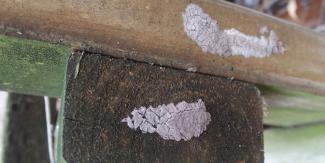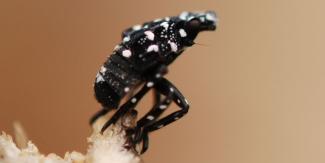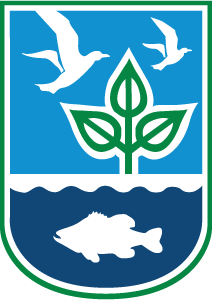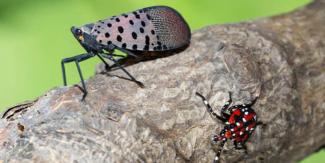Spotted Lanternfly
The Spotted Lanternfly (SLF) is an invasive insect from China, first detected in Pennsylvania in 2014. Since then, it has spread quickly to nearby states. SLF harms important plants like grapes, apples, stone fruits, and walnuts, and is also a nuisance that affects outdoor activities. SLF was first found in Rhode Island in 2021 in Warwick, and in 2022, the first confirmed population was discovered in Smithfield along Route 7. Now, SLF is established in Providence and Kent Counties.
Spotted Lanternfly Management Resources
SLF does not kill every tree it feeds on. SLF is mainly a threat to agriculture, especially vineyards, orchards, and nursery crops. For most homeowners, SLF is a nuisance pest. It does not bite or sting, it will not infest homes, and it will not kill large, healthy trees.
Large infestations at home can be messy because of the sticky residue (honeydew) they produce, which can lead to sooty mold on outdoor surfaces that can be cleaned.
For more management control options, check out the Penn State Extension SLF Management Guide or the URI Biocontrol SLF Management.
Below are practical steps you can take to manage SLF around your home.
What You Can Do at Home
SLF adults lay masses of 30 or more eggs on surfaces ranging from tree trunks to patio furniture, so the public should check trees and surfaces like rocks, metal, outdoor furniture, and fencing for the masses, which are typically 1.5 inches long, greyish brown in color, and resemble clay. They can be found on surfaces anywhere from an inch above the ground to 7-8 feet high.
After finding an SLF egg mass, scrape the entire egg mass, using a credit card, paint scraper, or other flat, sturdy tool, into a bottle with rubbing alcohol or hand sanitizer, or crush them directly.

Squash insects when you see them. Use Circle Traps on or near affected trees to trap spotted lanternfly as they climb up trees (Penn State Extension DIY Trap Guide). A vacuum and an extension cord can also help remove clusters of insects from trees or surfaces. DIY mixes of soap, water and oil can be effective as an at-home sprayable solution. Over-the-counter garden insecticides, readily found at garden centers or hardware stores, like Neem Oil and other insecticidal soaps can also be effective.


As spotted lanternflies feed, they excrete a sugar-rich substance known as honeydew. Nuisance insects such as wasps and ants may be attracted to accumulations of oozing sap and honeydew. A build-up of honeydew may also become colonized by sooty mold fungi, which can act as a photosynthesis barrier.
Warm, soapy water (mild dish soap works well) and a soft brush or sponge can help scrub mold away. On cars and outdoor equipment, scrub with a similar solution or a gentle cleaner and water. Avoid strong chemicals that could damage paint or finishes.
For plants and shrubs in a garden, for example, spray leaves with water from a garden hose to wash off buildup. For delicate plants, use a gentle spray setting to avoid damage. Early monitoring and action are key when managing honeydew in a garden.
Although they can fly distances on their own, Spotted Lanternfly are excellent hitchhikers and mainly spread through human movement.
Their inconspicuous egg masses can be laid on pallets, vehicles, and other goods. It’s important to check your vehicles and outdoor equipment (grills, outdoor furniture, landscaping supplies, mowers, etc.) before traveling to and from Rhode Island, and scrape off any egg masses.
Checking vehicles, trailers, campers, and outdoor items before moving them within or out of state is crucial to reducing the spread. Do not move firewood or plant material from infested areas.
SLF prefers Tree of Heaven (Ailanthus altissima). If you have this tree on your property, consider removing it. In some cases, licensed professionals can treat selected “trap trees” so removal is not always recommended, as this can cause SLF populations to migrate to other host trees on your property and be more difficult to locate and manage.
Insecticides applications are usually not necessary for homeowners. If you grow grapes, fruit trees, or other valuable plants and SLF is causing damage, consult a licensed arborist or pest control professional for potential insecticide treatment. Be aware of flowering plants nearby to the proposed treatment area, as insecticides can kill pollinators, who are crucial to both the environment and agriculture.
There are many factors to consider before deciding to use an insecticide to kill SLF, including:
- the number of SLF present,
- whether they are on a preferred host plant where they are likely to remain or on a plant they will move away from after a shorter visit,
- the size and health of the plant,
- the presence or absence of preferred host plants in the landscape,
- and the life stage of SLF present.

If you suspect you have found a spotted lanternfly
DEM is currently prioritizing points of spread (shipping hubs, rail lines, moving companies, highways, etc.) and agricultural areas (vineyards, orchards, nurseries, and farms).
- Please DO NOT submit a report if you’re reporting from Providence or Kent County, as these areas already have established populations of SLF. To manage SLF at home, please visit our management resources.
- Reports are helpful in counties outside Providence and Kent, at transportation hubs, and on agricultural properties, including vineyards, orchards, nurseries, and farms.
If you suspect you have found a spotted lanternfly in Bristol County, Newport County, and Washington County, take a photo and report it to DEM's Pest Alert Form. Reports help DEM track the spread of SLF, guide management activities, and protect Rhode Island farms and forests.
Report SLF in Bristol County, Newport County, or Washington County
Additional Resources
- URI Biocontrol Projects: Spotted Lanternfly
- Penn State Extension’s What to Look For page.
- SLF News: ARS Scientists Seek Answers from Spotted Lanternfly Dispersal
- SLF News: Spotted lanternflies have infested the region and researchers are hard at work trying to control their spread
- SLF News: Vineyards Facing An Insect Invasion May Turn To Aliens For Help
- SLF News: Plant Pro: Spotted Lanternfly
- SLF Lookalikes
- SLF Egg Scrape Card Template
- How to Remove SLF
- USDA Outreach materials to help stop the spread: Poster / Truck Driver Checklist / Employee Parking Lot Sign / Truck Bumper Sticker/Signs / Window Sign
About Spotted Lanternfly

- SLF will not invade homes or breed indoors (they feed on sap and stay on plants and outdoor surfaces).
- SLF is not toxic, poisonous, or harmful to people or pets.
- SLF will not bite or sting people or pets.
- SLF will not kill large, mature trees. It has only been known to kill grapevines, Tree of Heaven, and Black Walnut saplings.
- SLF will not continue reproducing year-round (they die off after the first or second hard frost each winter, and only the eggs survive to the next season).
- SLF will not ruin vegetable gardens - SLF will feed on vegetable, fruit, and herb plants during the nymphal stage, when they are most vulnerable. However, damage is seldom reported and only seen when plants are subject to very high SLF populations.
- SLF will not cause structural damage to houses, fences, or buildings - they are sapsuckers.
Spotted Lanternfly (SLF) is a type of “true bug” that uses a stylet (or beak) to pierce plant tissue for feeding. In addition to the spotted patterning, the adult SLF’s unique colors feature scarlet underwings, yellow markings on its abdomen, and tan semi-transparent forewings.
The nymph stage appears in June and July. They feature strikingly bright red and black bodies with white spotting. Early stage nymphs lack the red color and appear completely black.
Adults, about an inch in length, can be found from late July to November. Adult lanternflies are active from August until the first hard freeze, which typically occurs from late October into November.
Quick ID
- Egg masses are covered with a gray-brown substance, flat, and laid on many surfaces, most commonly trees.
- Long legs make SLF strong jumpers; both nymphs and adults often jump when prodded or approached.
- Early nymphs have black bodies with bright white spots.
- Late nymphs are colorful, red, and roughly the size of a nickel.
- Adults have hind wings with red patches and gray forewings with black spots and veins. When folded, only the forewings are visible and provide camouflage against tree bark.
SLFs are commonly attracted to the invasive Tree of Heaven (Ailanthus altissima) but also threaten many fruit crops such as apples, apricots, cherries, grapes, hops, nectarines, peaches, and plums as well as native maple, oak, pine, poplar, sycamore, walnut, and willow trees. Rhode Island is at high risk of this invasive pest that can cause significant damage to agricultural crops and trees and affects the quality of life and enjoyment of the outdoors.
As SLF feeds, the insect excretes honeydew (a sugary substance), which can attract bees, wasps, and other insects. The honeydew also builds up and promotes the growth of sooty mold (fungi), which can cover the plant, forest understories, patio furniture, cars, and anything else found below SLF feeding.
SLF was first detected in Pennsylvania in 2014 and quickly spread through surrounding states.
In 2021, a confirmed finding of a single Spotted Lanternfly (SLF) was recorded for the first time in Rhode Island in an industrial/commercial area in Warwick near Jefferson Blvd.
In August 2022, DEM found an additional credible report of an invasive Spotted Lanternfly sighting in Smithfield. Patches of SLF found along Route 7 in Smithfield indicated Rhode Island's first confirmed population of SLF. This was later confirmed by the US Department of Agriculture (USDA).
DEM is currently surveying the area to determine the extent of its spread and working with USDA and the University of Rhode Island to minimize its spread. To date, SLF is established in Providence and Kent County.

